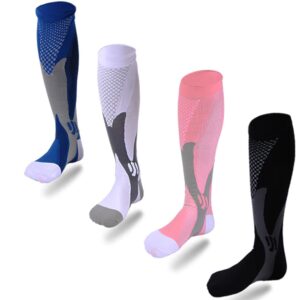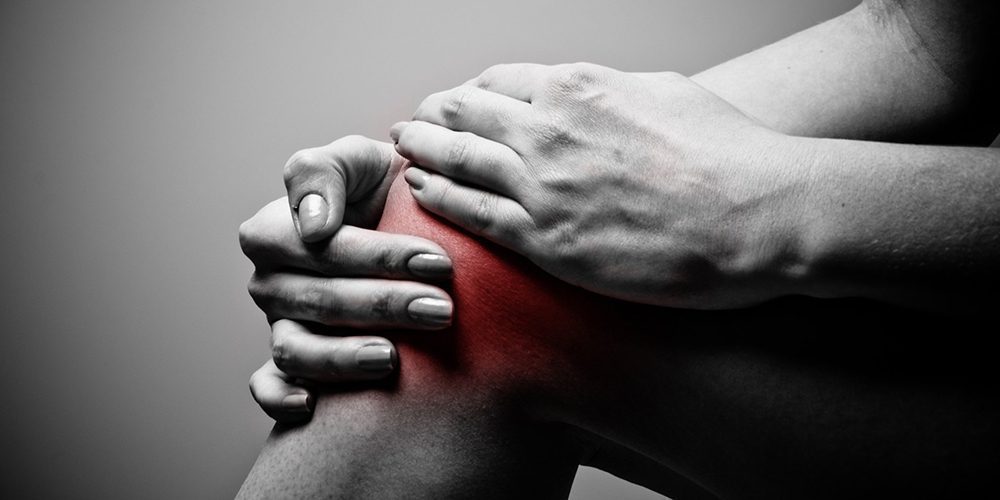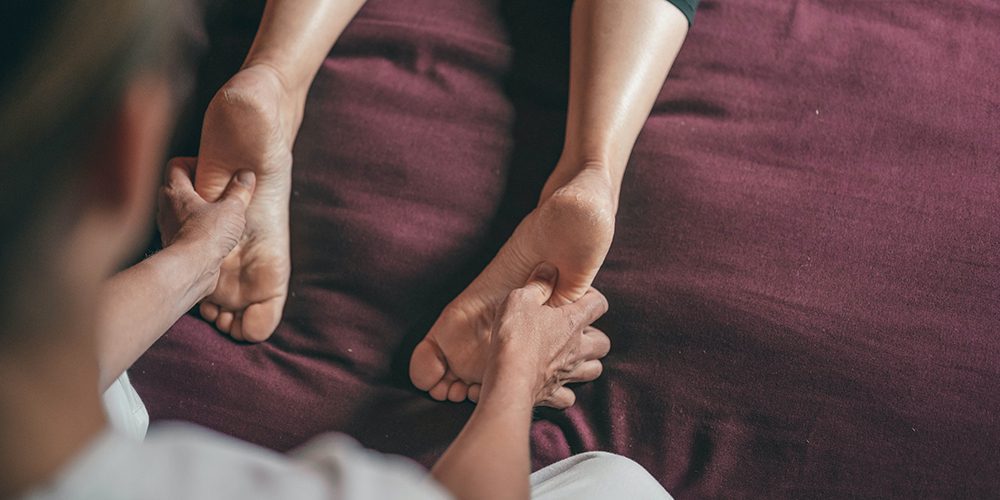The bursa is a small, fluid-filled sac that cushions areas where bone would otherwise rub on muscle, tendons or skin. When a bursa becomes irritated by overuse or excess pressure it can get inflamed and cause pain to the patient.
What is bursitis?
Bursitis is the inflammation of any bursa in the body. There’s a bursa located at most major joints, such as the shoulder or the elbow. But these are by far not the only body parts that can hurt because of an inflamed bursa. You can also have bursitis in your heels, knees and toes.
When the bursa becomes irritated it reacts with swelling. And that swelling causes pain in your joints. This pain can either be sudden or build up over time.
Because this article is part of our foot pain series, we will concentrate on bursitis in your heels and feet for the most part.
Where does bursitis occur?
Your body is home to more than 150 bursae. But not all of them are prone to inflammation. Most likely you develop bursitis in joints that you use over and over with the same movements or that are in places needing to withstand a lot of pressure.
By far the most affected area are the shoulders (subacromial bursitis). The pain from bursitis in this area is mostly felt on the outer side of your shoulder.
The second most affected body parts are your elbows (olecranon bursitis). This is especially true if you’re a physically active person and/or you do a lot of lifting.
Knees (prepatellar bursitis) are especially prone to inflammation when you kneel down repeatedly on the same area for a prolonged period of time.
Additionally, your feet (commonly the heels, big toe or ball of the foot) are particularly at risk when you are active on uneven ground, when you wear high heels or when your toes always stay in tight shoes.
You can get bursitis in your hips (iliopectineal bursitis) as well. This is a rare occurrence. When this happens, it mostly affects people who do a lot of walking or cycling.
And finally I want to mention the buttocks (ischial bursitis). This is a bursa that protects the skin from regular pressure and friction of sitting down. However, you can also develop inflammation in this bursa if you sit on a hard surface almost all day long everyday.
Symptoms
The symptoms of this inflammatory condition are pretty easy to recognize. They include swelling, pain and warmth in the joint that houses the inflamed bursa. Additional signs to look out for are redness, tenderness or even a lump that can be felt just above the joint.
Additionally you may have problems moving your joints because they feel achy or stiff.
While those symptoms are nothing to worry about too much, you should see a doctor if you have:
- Pain that makes it impossible to move
- Inability to move your joint at all
- Sharp and shooting pain when exercising
- Fever along with other symptoms
- Excessive swelling, redness, bruising or a rash
Risk factors – Who gets bursitis?
Everyone can develop bursitis. But you’re more at risk if you are doing repetitive tasks during your job, hobby or sports. A good example is a baseball pitcher who, in most cases, only uses one arm in a repetitive motion. Or tennis players, mainly through a bad serve motion that is used over and over again.
Musicians are prone to developing bursitis as well. That’s because they use their instruments in a repetitive fashion.
Generally speaking, the older you get, the more likely it is to develop bursitis. So older age is definitely a risk factor. Conditions such as arthritis, diabetes or thyroid disease favor the development of bursitis too.
Causes
We learned that repetitive motions benefit the development of bursitis. But spending time in positions that put heavy pressure on your joint over an extended period of time can cause a flare-up. This includes kneeling, standing in awkward positions, resting in a squat position or distributing your weight more to one specific side/leg. Common activities that cause bursitis include:
- Sports like baseball, tennis or golf
- Shoveling for extended periods of time
- Scrubbing
- Gardening and raking, especially when kneeling
- Carpentry
- Painting, especially over head
- Tile setting
- Cleaning
Diagnosis
In case you should experience the above mentioned symptoms, please make sure to contact your healthcare provider or a doctor. During the physical exam, your doctor will ask you questions about the pain and will most likely order X-Rays and Ultrasound or MRI images to rule out other conditions. In rare cases a sample of fluid from the bursa is taken, but only if it is infected already.
Treatment
In the vast majority of cases, you can treat bursitis yourself at home. Rest is inevitable so you need to avoid activity to prevent further injuries and shorten the recovery time. It is extremely important that you stop the repetitive motions or activities that caused this bursitis immediately until you’ve fully recovered.
From experience I can tell that the following treatments are the most successful ones:
- Apply ice packs to reduce swelling
- Elevate the injured area or body part
- Apply heat to relieve ongoing pain
- Use a splint, brace or support to stabilize the injured area
- Take over-the-counter anti-inflammatory medications such as Ibuprofen
- Physical therapy helps to increase range of motion
- If the bursa is infected, antibiotics may be needed
- Occupational therapy helps with long-term changes
If all these treatment options fail and you should still don’t feel better after 6 months, surgery may be the only solution.
Prevention
Because most cases of bursitis are caused by repetitive tasks, you can prevent this condition. One way is to make small changes in the repetitive activity. If you’re a golf player for example, you can change your grip or purchase special gloves. Maybe try stretching more after playing on the course or even wearing wrist braces during play.
Avoiding and changing the activity that causes these problems is vital. So take it slow and make sure to work on your technique, if it’s a sport that caused your bursitis. If kneeling down while gardening or tile setting, use proper knee pads to reduce the pressure on your joints.
Work on your posture. This may sound like a cliché, but poor posture can lead to bursitis.
When starting new exercises, sports or activities, be sure to start them slow to avoid injuries from the get go. You can even stretch first to make sure you work on increasing your strength and flexibility gradually.
Supports, pads, compression gear and protection wear are your best friends, once you’ve experienced a condition as bursitis that can put you out of business for a few months. And I know what I am speaking of. Not being able to play your favorite sports or participate in your favorite activity really reduces the quality of life. So don’t risk it and protect yourself. Prevention is definitely the best treatment you can do.
FAQs
Can you get bursitis again?
Once you’ve had bursitis, it can come back especially if the same activities are still being performed. A change in your behavior is definitely necessary to avoid bursitis from striking again.
Is bursitis curable?
Bursitis is usually a short-lived condition. In many cases it lasts only for a few days to weeks. Giving your joint the necessary rest is all it needs in many cases.
How long does it take for a bursitis to go away?
It varies depending on the severity of your condition. The condition can be caused by a single event, like an ankle sprain or it may develop over time through constant use. The longer you’ve had the condition, the longer it will take to recover.
What happens if bursitis is left untreated?
If bursitis is left untreated it can develop into a long-term condition. Your body will become weaker and your joints may lose mobility and you’ll experience pain constantly. That makes doing the most basic of tasks difficult, if not impossible to perform. Once you’ve developed a chronic bursitis, it is very hard to reverse without surgery.
What is the best anti inflammatory for bursitis?
Ibuprofen works best to reduce the swelling and resulting pain caused by an inflamed bursa. You can also use aspirin or naproxen for this purpose, but Ibuprofen is the most common anti-inflammatory drug recommended for bursitis.
What can be mistaken for bursitis?
Tendonitis is often mistaken for bursitis. The difference between tendonitis and bursitis is that bursitis develops in the pockets, while tendonitis affects the sheath surrounding a muscle or tendon.
If you have any experiences with bursitis, or want to share your tips for preventing this condition in the future, please let us know by leaving a comment below. We would love to hear from you!























One Response
A flare up has left with difficulty walking in fact I was unable to walk. After 24 hours in A+E I hah physio and I am now walking with a stick.
The worrying thing is will I ever get better. I have a manual car and I am now unable to drive it.